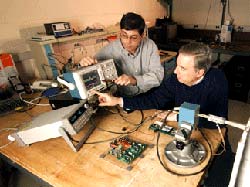Researchers Developing Technology to Detect Hidden Mold Behind Gypsum Wallboard

Researchers are testing the feasibility of using radar technology to detect mold behind gypsum wallboard. They are using a signal processing algorithm and high-sensitivity, laboratory-size radar system recently developed by the Georgia Tech Research Institute. <br>Georgia Tech Photo: Gary Meek
Researchers are testing the feasibility of using radar technology to detect mold behind gypsum wallboard. A common problem, hidden mold can cause serious structural damage and health problems before homeowners discover it.
Hoping to develop a non-destructive and less expensive method than is now available to detect mold behind walls, Georgia Tech Research Institute (GTRI) scientists are collaborating with humidity control expert Lew Harriman of Mason-Grant Consulting in a two-year feasibility study primarily funded by the U.S. Department of Housing and Urban Development (HUD) through its Healthy Homes Initiative. The Air-Conditioning and Refrigeration Technology Institute in Washington, D.C., and Munters Corporation in Norcross, Ga., are also providing funds for the study.
“Mold is a common problem, especially in humid, southern climates, but people are often not aware of it because it’s occurring behind a painted or wallpapered wall,” said GTRI research scientist Victor DeJesus. “Then it’s too late when they realize it. The wallboard must be replaced.”
In addition to degrading structures, mold can emit smelly and potentially harmful compounds into the air, DeJesus added.
Researchers are conducting experiments on damp, mold-infested wallboard panels. Initially, they are using a signal processing algorithm and high-sensitivity, laboratory-size radar system recently developed by GTRI principal research scientist Gene Greneker and senior research scientist Otto Rausch.
They will determine the feasibility of using millimeter-wave, extremely high-resolution radar to detect mold in these panels based on unique characteristics of the mold backscatter signature, extracted by unique signal processing techniques. Also, Harriman will investigate the possibility that X-ray and gamma-ray technologies might work. And later, the researchers will examine the effectiveness of these techniques in detecting mold in other indoor building materials, including ceiling tiles typically used in commercial structures.
Ultimately, the researchers hope to produce a small, handheld prototype unit – something akin to a stud finder – to lay the technical foundation for a commercial product that contractors could purchase for about $1,000 to $2,000 and easily learn to use. They would then test that prototype in actual houses.
Radar expert Greneker envisions a system that would map mold behind a wall. If dampness is indicated by the radar-based device, then a contractor could know more precisely where to probe for damage, he explained.
“We think this technology is on the cutting edge for detecting mold behind walls,” Greneker said. “Its potential is immense.”
In an initial experiment that began in January 2004, researchers used a small panel of wallboard — which is very porous — soaked in water and injected with non-toxic fungal spores. In one month’s time, those spores germinated as the wallboard was kept in a high-humidity environment. Mold thrives in damp wallboard because of its paper-based encasing, DeJesus explained.
Researchers then used the radar system to scan the wallboard panel, and they were encouraged by the early results. Now, they are tweaking the algorithm to enable the radar system to discriminate between the mold backscatter signature and nails, boards and wiring that would be found in and behind wallboard, Greneker said. They must also find ways to reduce the system’s cost, while retaining its sensitivity, he added.
This experiment and a larger-scale one that began this spring simulate what might happen to wallboard dampened by a home’s leaking pipe or roof, or from condensation formed by a HVAC system, or even from high-humidity conditions, DeJesus said.
If left unattended, mold can destroy structures and cause serious health problems. The researchers cite a well-known case in which a jury awarded $32 million in damages to plaintiffs in Texas who sued over a neurological condition and asthma their doctors attributed to mold in the home they purchased.
In less serious cases, the consequences can still entail a lengthy and costly repair process, the researchers say. A contractor must pinpoint the damaged area by drilling holes in the wall. Rotting wallboard, insulation and, perhaps, studs must be removed, the area dried and then decontaminated before new wallboard can be installed.
Media Contact
More Information:
http://gtresearchnews.gatech.edu/newsrelease/moldradar.htmAll latest news from the category: Process Engineering
This special field revolves around processes for modifying material properties (milling, cooling), composition (filtration, distillation) and type (oxidation, hydration).
Valuable information is available on a broad range of technologies including material separation, laser processes, measuring techniques and robot engineering in addition to testing methods and coating and materials analysis processes.
Newest articles

Parallel Paths: Understanding Malaria Resistance in Chimpanzees and Humans
The closest relatives of humans adapt genetically to habitats and infections Survival of the Fittest: Genetic Adaptations Uncovered in Chimpanzees Görlitz, 10.01.2025. Chimpanzees have genetic adaptations that help them survive…

You are What You Eat—Stanford Study Links Fiber to Anti-Cancer Gene Modulation
The Fiber Gap: A Growing Concern in American Diets Fiber is well known to be an important part of a healthy diet, yet less than 10% of Americans eat the minimum recommended…

Trust Your Gut—RNA-Protein Discovery for Better Immunity
HIRI researchers uncover control mechanisms of polysaccharide utilization in Bacteroides thetaiotaomicron. Researchers at the Helmholtz Institute for RNA-based Infection Research (HIRI) and the Julius-Maximilians-Universität (JMU) in Würzburg have identified a…



